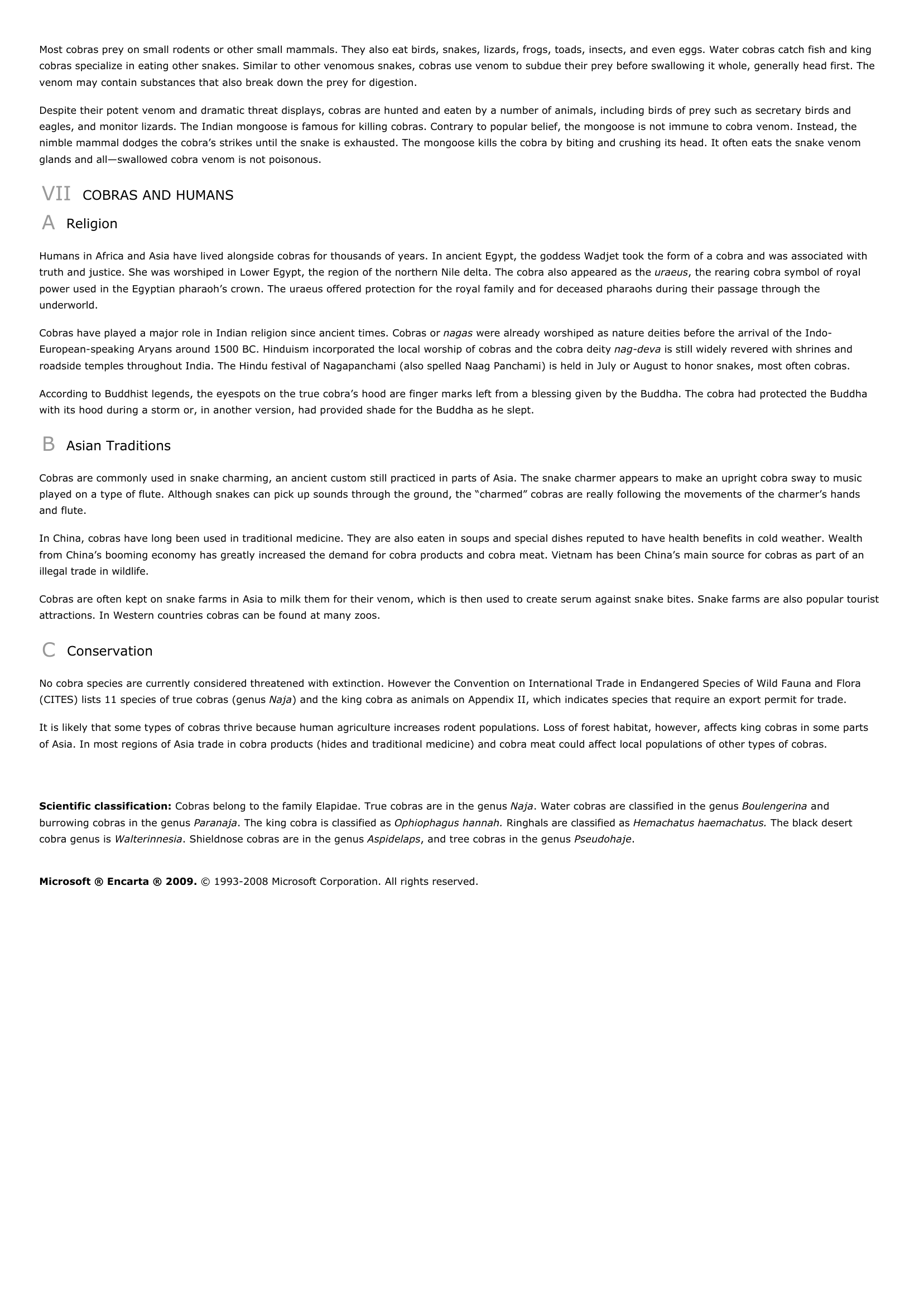Cobra (snake) - biology.
Publié le 11/05/2013
Extrait du document
«
Most cobras prey on small rodents or other small mammals.
They also eat birds, snakes, lizards, frogs, toads, insects, and even eggs.
Water cobras catch fish and kingcobras specialize in eating other snakes.
Similar to other venomous snakes, cobras use venom to subdue their prey before swallowing it whole, generally head first.
Thevenom may contain substances that also break down the prey for digestion.
Despite their potent venom and dramatic threat displays, cobras are hunted and eaten by a number of animals, including birds of prey such as secretary birds andeagles, and monitor lizards.
The Indian mongoose is famous for killing cobras.
Contrary to popular belief, the mongoose is not immune to cobra venom.
Instead, thenimble mammal dodges the cobra’s strikes until the snake is exhausted.
The mongoose kills the cobra by biting and crushing its head.
It often eats the snake venomglands and all—swallowed cobra venom is not poisonous.
VII COBRAS AND HUMANS
A Religion
Humans in Africa and Asia have lived alongside cobras for thousands of years.
In ancient Egypt, the goddess Wadjet took the form of a cobra and was associated withtruth and justice.
She was worshiped in Lower Egypt, the region of the northern Nile delta.
The cobra also appeared as the uraeus , the rearing cobra symbol of royal power used in the Egyptian pharaoh’s crown.
The uraeus offered protection for the royal family and for deceased pharaohs during their passage through theunderworld.
Cobras have played a major role in Indian religion since ancient times.
Cobras or nagas were already worshiped as nature deities before the arrival of the Indo- European-speaking Aryans around 1500 BC.
Hinduism incorporated the local worship of cobras and the cobra deity nag-deva is still widely revered with shrines and roadside temples throughout India.
The Hindu festival of Nagapanchami (also spelled Naag Panchami) is held in July or August to honor snakes, most often cobras.
According to Buddhist legends, the eyespots on the true cobra’s hood are finger marks left from a blessing given by the Buddha.
The cobra had protected the Buddhawith its hood during a storm or, in another version, had provided shade for the Buddha as he slept.
B Asian Traditions
Cobras are commonly used in snake charming, an ancient custom still practiced in parts of Asia.
The snake charmer appears to make an upright cobra sway to musicplayed on a type of flute.
Although snakes can pick up sounds through the ground, the “charmed” cobras are really following the movements of the charmer’s handsand flute.
In China, cobras have long been used in traditional medicine.
They are also eaten in soups and special dishes reputed to have health benefits in cold weather.
Wealthfrom China’s booming economy has greatly increased the demand for cobra products and cobra meat.
Vietnam has been China’s main source for cobras as part of anillegal trade in wildlife.
Cobras are often kept on snake farms in Asia to milk them for their venom, which is then used to create serum against snake bites.
Snake farms are also popular touristattractions.
In Western countries cobras can be found at many zoos.
C Conservation
No cobra species are currently considered threatened with extinction.
However the Convention on International Trade in Endangered Species of Wild Fauna and Flora(CITES) lists 11 species of true cobras (genus Naja ) and the king cobra as animals on Appendix II, which indicates species that require an export permit for trade.
It is likely that some types of cobras thrive because human agriculture increases rodent populations.
Loss of forest habitat, however, affects king cobras in some partsof Asia.
In most regions of Asia trade in cobra products (hides and traditional medicine) and cobra meat could affect local populations of other types of cobras.
Scientific classification: Cobras belong to the family Elapidae.
True cobras are in the genus Naja .
Water cobras are classified in the genus Boulengerina and burrowing cobras in the genus Paranaja .
The king cobra is classified as Ophiophagus hannah. Ringhals are classified as Hemachatus haemachatus.
The black desert cobra genus is Walterinnesia .
Shieldnose cobras are in the genus Aspidelaps , and tree cobras in the genus Pseudohaje .
Microsoft ® Encarta ® 2009. © 1993-2008 Microsoft Corporation.
All rights reserved..
»
↓↓↓ APERÇU DU DOCUMENT ↓↓↓
Liens utiles
- Garter Snake - biology.
- Python (snake) - biology.
- Snake River.
- Cobra (art) - peinture.
- Cobra royal: Le plus long serpent venimeux au monde.

































